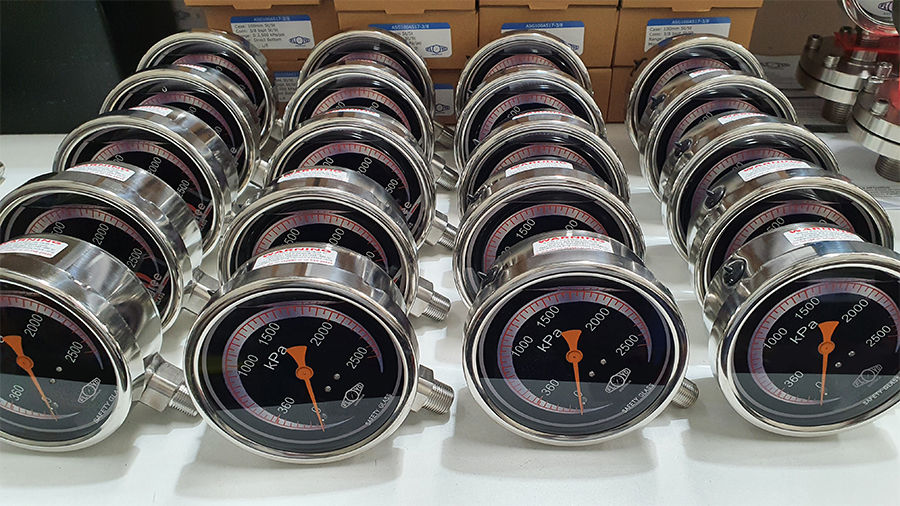
At Floyd Australia our Customer support team is dedicated to providing 100% commitment for all customer enquiries. If you have an enquiry regarding this website or you just want more information about our products and services then either contact us direct on the company details provided or please fill out our contact us form, then press submit, and a friendly customer support team member will reply to your enquiry.


There are many factors that affect proper pressure gauge selection but if you follow this brief pressure gauge selection guide and steps then the selection becomes simpler and more exact.
The first step of this pressure gauge selection guide is to identify the process media. The process media that the pressure gauge will be subjected to is critical in the primary selection of a pressure gauge. The two most widely used pressure gauges have either a brass connection with an internal phosphor bronze bourdon tube or a 316 stainless steel connection and internal bourdon tube. Consulting a chemical compatibility chart will assist in initial pressure gauge selection. Diaphragm seals, are connected to pressure gauge, and are available for use in all industries including food and beverage, petroleum, chemical, paper and pulp, corrosive and non-corrosive applications where the process media may contain solid particles which would inhibit the life of a bourdon tube pressure gauge. Kindly note that pressure gauges for use on gases such as Oxygen, Acetylene, etc are of special construction, consult your Floyd Australia for technical advice.
Another major factor in this pressure gauge selection guide is the process pressure. The range of the pressure gauge should be twice the system operating pressure. If the system pressure is nominally 800 kPa, then a 1600 kPa pressure gauge is recommended. If fluctuating pressures are present, the gauge should be liquid filled to reduce the stress on the internal bourdon tube and extend the life of the gauge.
The reason why the environment is critical in pressure gauge selection is, that if the pressure gauge is subjected to a harsh environment where corrosive or dust materials may enter the gauge then a hermetically sealed and/or liquid filled should be requested. In addition, if the pressure gauge is subjected to excessive heat then remote mounting is highly recommended. This is why the Environment is a key factor in this pressure gauge selection.
Pressure gauge accuracy is expressed as a percentage of the full-scale deflection (FSD). If the gauge has a stated accuracy of +/- 1% FSD and the gauge has a span of 4000 kPa, then the inaccuracy of the gauge could be +/- 40 kPa over the entire range. Pressure gauge accuracies may vary from +/- 3% to 0.25% of FSD. Critical to non-critical accuracy requirements will determine the proper selection of your pressure gauge. Calibration certificates indicating pressure gauge inaccuracies over the span are available on request. In an environment such as manufacturing facilities and industrial plants, accuracy must be considered and used in pressure gauge selection guides
Floyd Australia offers pressure gauge sizes (dial size) from 50mm up to 300mm and is determined by readability requirements. The most popular gauge sizes are 63mm, 100mm, and 150mm. More accurate pressure gauges generally have larger dial sizes.
In Australia, standard pressure connections are 1/8 BSPT, ¼ BSPT, 3/8 BSPT, and ½ BSPT dependent upon gauge size. NPT and BSPP thread sizes are also available upon request.
Pressure gauges are mounted in the following ways:- Direct mount, bottom entry (most common, mounted by process connection at the 6 o’clock position Direct mount, rear entry (process connection at the rear of gauge, either center rear or bottom rear. Surface mount, bottom entry (rear three-hole mounting flange for wall mounting, process connection at the 6 o’clock position Flush mount, rear connection (front three-hole mounting flange for hole mounting, process connection at the rear of gauge, either center rear or bottom rear. Panel Mount, rear connection, (“U” clamp hole mounting, process connection at the rear of gauge, either center rear or bottom rear. Pressure gauges are usually positioned upright. For gauge type compatibility in situations where the pressure gauge is positioned sideways, horizontally, or upside down, contact Floyd Australia Customer Service so we can provide a more specific and suitable pressure gauge selection guide.
All of the aforementioned factors must be considered to guarantee safe and accurate pressure gauge selection. If in doubt, please contact your Floyd Australia Customer Care for assistance!